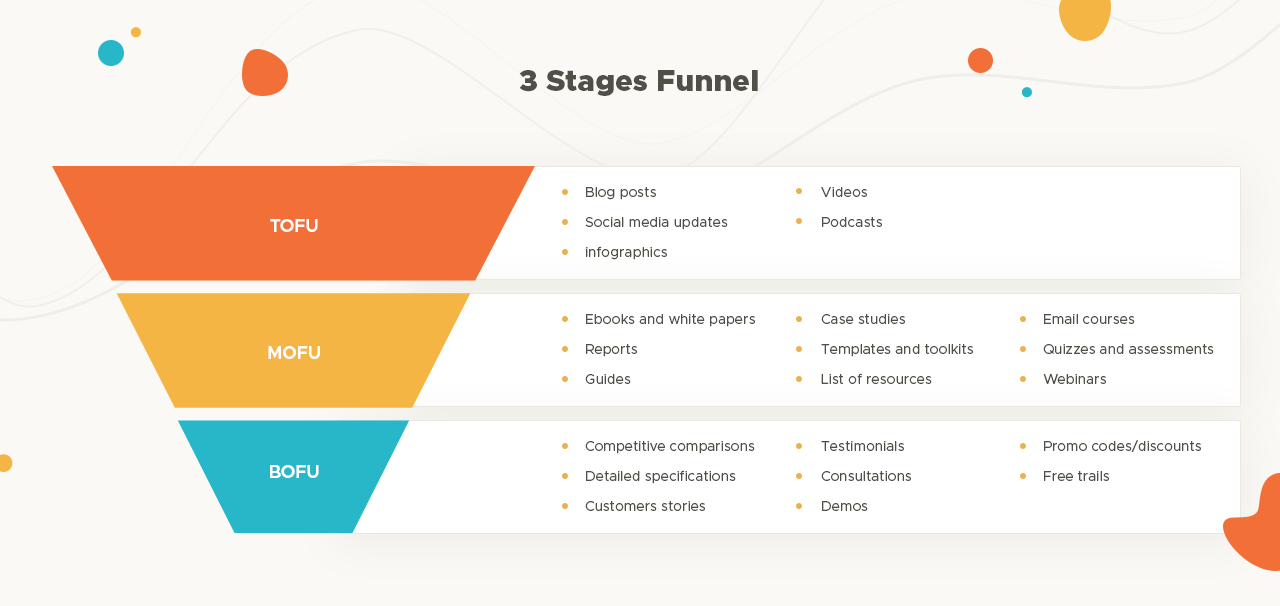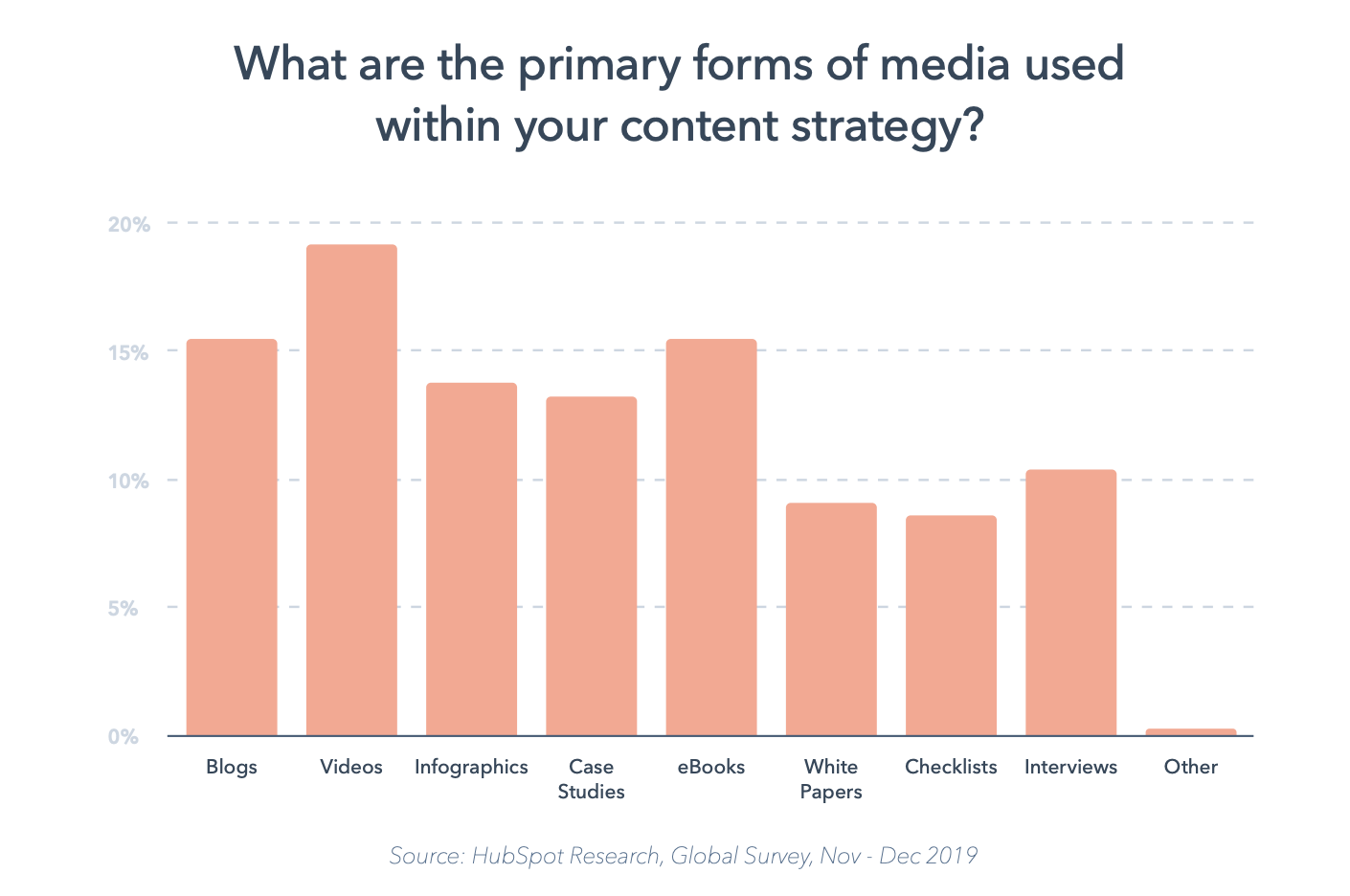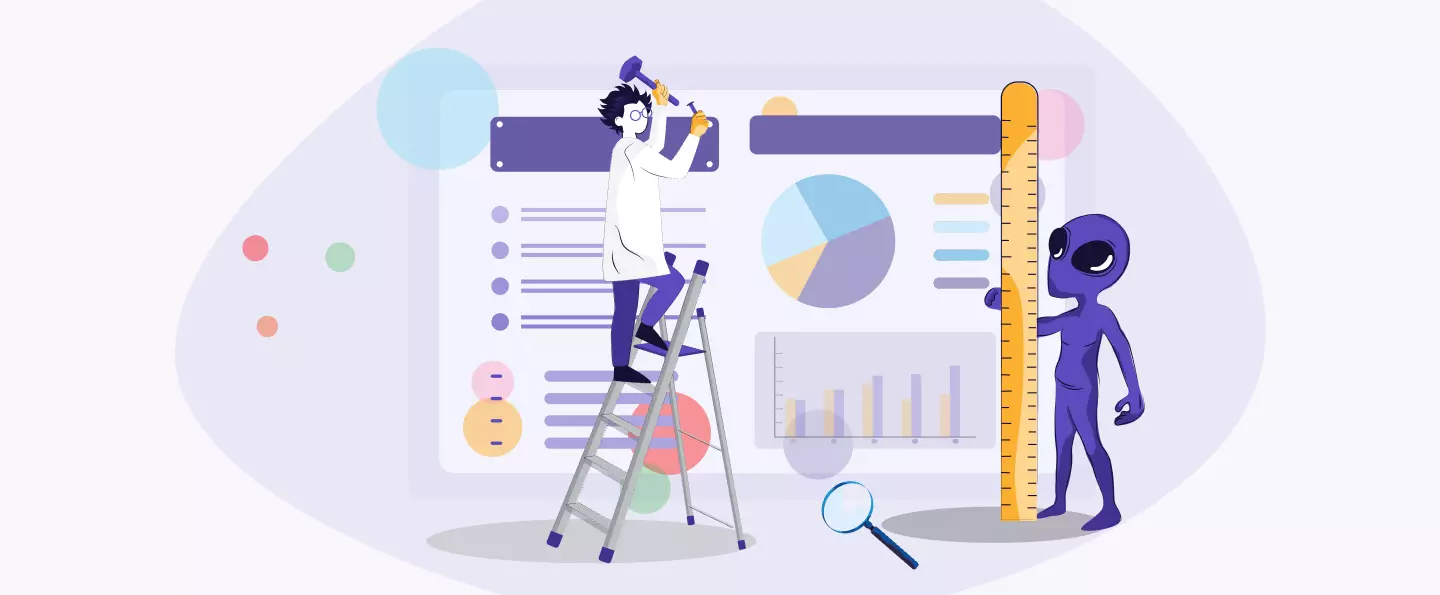Sending your data to our servers, please wait...





Oops... No results found.
Please try a different search phrase.
Digital Marketing 16 min read
Content Marketing & The Marketing Funnel: The Definitive Guide
Written by Dallin Porter
Marketing Director @ Galactic Fed
Expert reviewed by Dallin Porter
Marketing Director @ Galactic Fed
Published 31 Jul 2020
It’s the “C” word being heard daily around the world: content. From big brands to tiny startups, companies from all industries are taking “content is king” seriously, and it’s seemingly what separates the prince from the pauper.
While this has drastically changed the way businesses can attract, engage, and inform consumers, it also leaves a lot of them scratching their heads asking the question: what content should I create to get the results I want? Especially when it’s estimated that the average customer will view 3-5 pieces of content before reaching out to a brand, and that 78% of companies have a content team of at least 1-3 people.
Galactic Fed is no stranger to content strategy - we build these out for ourselves and our clients, and recognize it as a crucial factor to success. Based on our expertise, we will break down in this article the content marketing funnel in all its glory - including what types of content align with the different parts of the marketing journey, and which audiences need to see it. It’s been said that a great content strategy is less about a presentation, and more like a Q&A - you research the questions your customers are asking, and then use your content to give them the answers they need. Now, it’s time for some answers.
Marketing Funnel Overview
The Marketing Funnel has many variations but the overall messages are the same, no matter which version you’re looking at. In its most basic form, the marketing funnel has three stages: Top of the Funnel (TOFU), Middle of the Funnel (MOFU), and, you guessed it, Bottom of the Funnel (BOFU.)

While all sections of the funnel serve different purposes, the idea of a cohesive content strategy is that it guides the buyer through every stage, helping your customer navigate your products and brand like a content sherpa. The purpose of the TOFU stage is to create awareness, or the discovery stage. This is the widest part of the funnel since any consumer has the chance to be attracted to your brand through TOFU content. This type of content grabs attention, is broader in topics and reach, and shows prospective customers that you have the solution to at least one of their problems. Don’t worry, we will get into specific types of content that are most helpful in just a bit.
The MOFU stage is often referred to as the consideration stage. This takes place when a qualified lead begins deciding if your product or service is right for them. This may look like comparing against competitors, or reading reviews of your brand. Some common types of MOFU content are case studies, E-books, or guides (kind of like this one) that begin to provide meaningful value to someone who has you on their radar.
Then comes the BOFU stage. Commonly known as the purchase, action, or delight stage. This is the stage where the potential customer decides they can’t live without your product or service, and that you’ve successfully guided them from top to bottom, a journey that is hopefully supplemented by your amazing content. The BOFU portion of the marketing funnel can be a bit more tailored and personalized. Think things like free trials, testimonials, or promo codes; items that give one final push towards a purchase or taking action.
It’s important to note that in an ideal world, customers don’t move through your content marketing funnel once and then are never to be seen again. A perfect content strategy would be cyclical, one that continues to guide prospects through the stages over and over, essentially creating repeat or lifelong customers. Now it makes sense why 70% of companies are investing in their own content marketing strategy.
Above all, remember that content should not be created just to exist. The best content is the one that is unique, that solves problems and answers questions. Lee Oden, CEO of TopRank put it best: “content marketing will continue to drive visibility in 2020 but what good is being found if the content is not credible or compelling? To win the content marketing game, brands need to focus more on optimized, personalized and influencer activated content experiences.”
Top of the Funnel (TOFU)
Let’s dive into the specifics of what type of content is best suited for each stage of the marketing funnel. Although there are seemingly endless content directions, we are going to highlight two for each that we’ve seen the most success with, so that hopefully you can too.
Paid Ads: We could go on forever about the importance of Paid Ads, since it’s some of what we do best at Galactic Fed, but the value of a well placed ad cannot be understated. Google has said that for every $1 spent on Google ads, companies see an average revenue of $2, which is an extremely promising statistic. When you couple that with the fact that in the US alone, “ad spending will surpass 86 billion U.S. dollars by 2023, the possibilities are gargantuan. When you consider, then, that revenue from search ads is expected to grow by roughly ten percent in 2020, you can understand why this has become a huge focus for almost every business and industry.
One step further: When it comes to crafting your ads, Galactic Fed Co-Founder, Zach Boyette, said “Figure out the “personality” of your copy and infuse it into the writing. Is the tone of voice sarcastic? Straightforward? Optimistic? This should be woven through every sentence. Also, the most effective copy is “copy that tells the consumer what you’re doing. Say what YOU can do for THEM.”
Blog: When businesses are asked what are the primary forms of media used within your content strategy, blogs were one of the most consistently common answers. Although a blog is nothing new or revolutionary, it can be the perfect catalyst for your content marketing strategy. Your blog can act as a hub for all other types of content. Since it’s commonly owned media, you have total control over what content you produce and promote. One of the best things about a blog is that it is multi-purpose. It can establish your brand as an authority in your field, it can reiterate your brand voice, it can drive traffic to your website, and it can serve as a tool to build an online community, and see what pain points your customers are having that you can solve. Not to mention that you have a 434% greater chance at being ranked higher on Google if you include a blog as part of your website. It’s no wonder blogging has been around since the beginning of the internet.
One step further: Because corporate blogs seem to be a dime a dozen, producing content for the sake of it will be snuffed out quickly. The world does not need another “Top 10 Marketing Podcasts” blog, we promise. For example, this specific blog you’re reading right now was written out of knowing it is answering questions raised by our audience, the digital marketing crowd, has; such as “what is a content marketing strategy?” or “what types of content fit best with my business goals?” or “what the heck is a vlog?” This takes time and research; finding out where your audience is, and what concerns they have, and then addressing them directly.

Middle of the Funnel (MOFU)
Let’s move on to the MOFU stage. Customers who are at this point in your funnel have had their interest piqued and their attention caught. Thanks to your perfect written ad or problem-solving blog, they want to learn and/or do more. It’s with this type of content that you can provide a bit more context, background information, or showcase more of what you do best.
Case Studies: With 92% of customers preferring a media message that sounds like a story, case studies are the perfect fit, where your brand is the author. Case studies provide several insights for the readers. It serves as an extremely useful tool for publicity, as it highlights ways in which you’ve helped other customers and clients. While generally underestimated, case studies have the potential to paint a positive picture for your brand. They are similar to blogs, meaning you have total control in how you present them: facts, images, infographics, results, sales collateral - anything that helps you convey your message. Plus, with tools like Visme, you no longer have to be a graphic designer to create beautiful design assets. Then you can take a case study and use it as a catalyst for other content: turn it into a blog, video, or podcast episode.
One Step further: When producing your case studies, let the results speak for themselves. We include important statistics right in the title of our case studies, leading with the numbers. It’s also important to break it down for your reader, and tell the story. This typically includes an initial overview or problem posed by the client, such as wanting to generate more qualified leads, and then step by step explains the execution or strategy. Finally, end with the results: crunch the numbers and show the facts so that potential customers in the MOFU stage will be jumping at the chance to move on to the next.
Newsletter: Hopefully your TOFU content is engaging enough that people decided they want more. One of the best ways to gauge this is email capture for a newsletter. Customers giving their personal information is a telltale sign that your content is performing well. Not only that, but creating a newsletter has endless possibilities for promoting your brand the way you want to. When surveyed, 93% of B2B marketers said that they use email newsletters as a way to share content, and 40% of content marketers say email newsletters are the most critical factor to their success. Because after all, what good is creating all of this content, if people aren’t going to see it? Newsletters are the perfect way to provide a curated email of what you want to share: promotions, announcements, social media accounts, blogs - almost anything, wrapped into one consumable package.
One step further: Since email is 40 times more effective in acquiring customers than LinkedIn or Twitter, it’s crucial your brand maximises its potential. If your digital marketing strategy is a conversation, your newsletter should be the icebreaker. While keeping the self-promotion minimal, it’s one of the best ways to drive your customer to your social media, increase your following, and create a space for community and meaningful conversations. Also, for the sake of your sanity, use an email automation tool like MailChimp, Drip, or Mailjet. This will save you invaluable time and manpower so you can get back to creating quality content.
Bottom of the Funnel (BOFU)
There’s no rock bottom here; The BOFU portion of your content marketing is where you want to bring all of your potential customers. If you have a lead or client in the BOFU stage, you’ve guided them along a content journey, provided them with sufficient information where they are now in the decision stage. They are looking to act, and sometimes all it takes is one final push.
Testimonial: Since a whopping 92% of people said they read testimonials before making a purchase, having the right ones on your website and in your marketing materials can be a deal maker or deal breaker. Not only are testimonials the original Yelp, but they have not lost their effectiveness, even as the internet has made it extremely easy to find a review on basically anything. When a client is vocal about their satisfaction of your work, have them give you a testimonial! Building up a bank of these over time will make it extremely easy to build brand trust, as people who aren’t being paid are backing up your business. You can share these on your blog or social media, and for someone who is on the fence about your business, reading about a similar experience from another person can seal the deal.
One step further: Because testimonials can be a dime a dozen, the generic “this was a great service” testimonial simply won’t do. As you build your portfolio of testimonials, you have the opportunity to make them more specific, and speak to different customers at different parts of the buyer’s journey (and marketing funnel!) Have some that speak about your customer service, some to the quality of your work, and some that talk about how quickly and easily you communicate. Then, once you identify the roadblock in your potential client, hit them up with testimonials that squashes their specific concern. We recommend this approach to anybody considering using testimonials (see what we did there?)
Freebie: It’s no secret that your future customers are looking at your brand with the “what’s in it for me” lens, which is why for those in the BOFU stage, offering a free service, such as a consultation, audit, or trial, proves to be one of the best closing strategies. There are, of course, a few caveats with adding a free service, like only offering when there is perceived value, both for you and your client. Also, this should not be the only strategy you have to rely on; consumers can sniff out desperate attempts for their money from a mile away. Set clear parameters to this free service, keep it succinct, and follow up! The whole idea of this freebie is that it provides a peak into the full service you’re offering, and just a taste will leave them wanting more.
One step further: Although “free” is one of the most beloved words in any language, it’s important to keep in mind this is only a tool to achieve your ultimate goal. You want to avoid solving your customers’ problems right out of the gate, rather, show them how you could use your free offer to provide solutions. Set up the framework for the services you would provide through a 3 day trial of your product or free social media audit, for example. Then, most importantly, set clear expectations for what you foresee the results of this free offer being: that they can’t live another day without giving you their business.
We’ve covered a lot of, ahem, content, and highlighted some of the most effective pieces in each part of the marketing funnel. This should serve as a guiding light to your own content strategy, identifying where your potential customer is in the funnel, and create several types of content that addresses their concerns and speaks to their needs. Marrying your content marketing with the marketing funnel is a surefire way to create lifetime customers, and in a world where content is king, your brand will be royalty.

Dallin Porter
Marketing Director @ Galactic Fed



